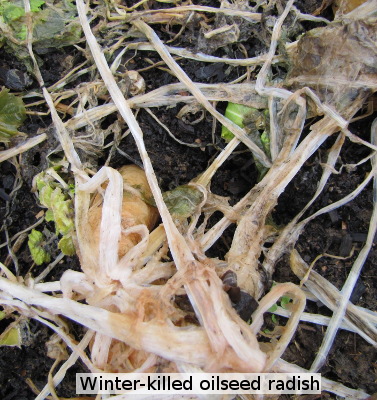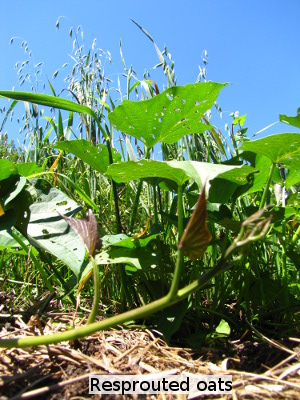
How to kill no-till cover crops
 The cover crop experimentation theme during
our first year has been killing
without tilling.
Traditional farmers use one of two techniques to demolish their cover
crops --- they plow the greenery into the soil or they spray it will
herbicides. Since neither of those options is appropriate to my
garden, I've had to try out several other methods, including:
The cover crop experimentation theme during
our first year has been killing
without tilling.
Traditional farmers use one of two techniques to demolish their cover
crops --- they plow the greenery into the soil or they spray it will
herbicides. Since neither of those options is appropriate to my
garden, I've had to try out several other methods, including:
- Winter-kill. This is my
favorite technique for cover crops planted in late summer or fall that
will be replaced by vegetables in the spring or summer. All you
have to do to winter-kill is choose cover crops that will reliably die
during your winter's coldest days. We live in zone 6, and the two
cover crops that winter-killed well for us were oats and oilseed radishes. In contrast,
crimson clover, barley, and annual ryegrass all did not winter-kill. If you live
further south, you might not have any winter-kill choices, but
northerners probably have more cover crops to choose from.
- Mow-kill. Supposedly,
mow-killing can work if you have time to leave your cover crop in place
until it reaches full bloom. In practice, I found this kill
method tough to implement since I wanted to get my spring garden in
before the cover crops flowered. I'd only plan on mow-killing in
the future if I had plenty of wiggle room between cover crop maturation
time and vegetable planting time. The one exception to the
mow-kill problem is buckwheat,
which seemed to mow-kill quite reliably for me last summer.
- Smother-kill. You don't
read about this technique much in the agricultural literature because
it's not really something you'd do on the scale of a whole farm.
However, in your backyard garden, it's not too tough to mow your cover
crop down to the ground at any age, top it off with the inch of compost
you were going to add to the soil anyway, add a few inches of straw or
grass clippings, and wait a couple of weeks until the cover crop dies
from lack of sunlight. You can even plant big seeds like squash
directly into the compost immediately, and the cover crops will have
decomposed enough to feed the seedlings by the time their roots get
down to the lower layer. Just be sure to smother all the way to
the edge of your garden bed or you'll end up with a ring of cover crop
around your mulched center. I've only tried this technique on two
cover crop varieties so far, but it worked very well with barley and okay with annual ryegrass.
 Weed-kill.
In a pinch, you can pull up your cover crops one at a time. Yes,
this is the method I used
this spring on a couple of dozen beds of oats, and yes, it did take
forever since I thought I could lay the oats back down on the soil
surface as a mulch and they instead rerooted and had to be weeded
again. In future, if I have to weed-kill, I'll take the cover
crops away to the compost pile --- the garden bed loses the biomass,
defeating the purpose of a cover crop, but at least I won't have to
keep weeding oats out of my sweet potatoes for two months.
Weed-killing should be a last resort, but it will work on any cover
crop.
Weed-kill.
In a pinch, you can pull up your cover crops one at a time. Yes,
this is the method I used
this spring on a couple of dozen beds of oats, and yes, it did take
forever since I thought I could lay the oats back down on the soil
surface as a mulch and they instead rerooted and had to be weeded
again. In future, if I have to weed-kill, I'll take the cover
crops away to the compost pile --- the garden bed loses the biomass,
defeating the purpose of a cover crop, but at least I won't have to
keep weeding oats out of my sweet potatoes for two months.
Weed-killing should be a last resort, but it will work on any cover
crop.
I'd be curious to hear
what your own experiences have been with killing cover crops without
tilling them into the soil. Am I missing any of the obvious
choices? Have you tried these techniques on cover crops I haven't
mentioned and had successes or failures to report? I'm still
learning and can benefit from anyone's experiences at this point.
Want more in-depth information? Browse through our books.
Or explore more posts by date or by subject.
About us: Anna Hess and Mark Hamilton spent over a decade living self-sufficiently in the mountains of Virginia before moving north to start over from scratch in the foothills of Ohio. They've experimented with permaculture, no-till gardening, trailersteading, home-based microbusinesses and much more, writing about their adventures in both blogs and books.
Want to be notified when new comments are posted on this page? Click on the RSS button after you add a comment to subscribe to the comment feed, or simply check the box beside "email replies to me" while writing your comment.

Geoffrey --- I've always wanted to chop and drop, but all of our weeds seem to be the type that do badly with that method. (Dandelions, violets, etc., will just send up new leaves quite happily all summer if you don't get the roots.) The grain cover crops seem to be similar, but anything that will mow kill should respond well to chop and drop.
Phil --- As far as I know, they aren't edible, although they're so beautiful that every fall visitor to my garden last year wanted to eat them. The seeds can be used to make oil, but Wikipedia says the oil is only good for biofuel, not eating. That said, I'm not so sure they're not edible, maybe just not very tasty?
I actually have that happen with a number of the "weeds"...I consider it a bonus. My soil is very sandy and acidic (up on a ridge of Tuscarora Sandstone just before it goes up the mountain...),so I am trying to get as much organic matter as I can into it. The soil also dries out quickly when exposed. The multiple crops of leaves are a welcome thing. (I have a bunch of Evening Primrose that I have been allowing to spread a bit that produces a nice batch of leaves for this. (they also make a nice addition to the salads...))
I figure it this way...the plants that break through the straw are obviously quite tough. I am guessing they are pulling up nutrients that I will want in the mulch layer of my garden...if they produce more, excellent. They MIGHT be competing with the other plants, but at the rate I am trimming them down, they will likely exhaust themselves in enough time, and their efforts improve my soil.
Your method does seem to be the standard permaculture way, but I've discovered that if you want the best yields from your garden, it's better to give your crop weedless space. Sure, your weeds are slowly building the soil, but they do compete with your crops. Instead, I rotate cover crops with vegetables, getting the best of both worlds --- competition free growing for my veggies and soil building in the interim.
How much your vegetables can handle competition tends to relate to how good your soil conditions are. So, if your soil is poor and really needs building, your veggies will have a hard time competing with your dynamic accumulators. That's the unfortunate result I got when I tried to intercrop comfrey with a nectarine in poor soil.
Of course, maybe I'm just too lazy (or the garden's too big) to cut the dynamic accumulators often enough. I can't seem to make it back through more often than once every two weeks, and that's really pushing it. Usually, each garden patch only gets weeded once every one or two months! (We grow every vegetable we eat all year, so it's a big garden.)
I have about 1/5 acre of weedy ground that I plant to cover crop over winter. Below is my current plan. I would love to hear some feedback on this. I do not have any machinery but can pay for such services if justified.
Goals: weed suppression, soil improvement, erosion control. Crop: 1. oats/vetch/clover. 2. oats for straw.
The ground will be lightly plowed after the first rains in mid october. I plan to hand-broadcast the seeds and need a good solution for how to cover them afterwards.
In the spring, I plan to kill the cover crop by cutting it down with a scythe, allowing it to smother itself under its own cuttings below a layer of straw harvested by the grain rows.
essentially, I will be creating a 1/5 acre compost pile that is low enough to not necessitate turning and covered by straw on top to preserve moisture and smother the cover crop.
I plant to plant a variety of vegetables into this. the bulk will be corn into the vetch rows, and peanuts into the pure oat rows. might do a batch of radishes before the peanuts as a quick spring crop to suppress nematodes.